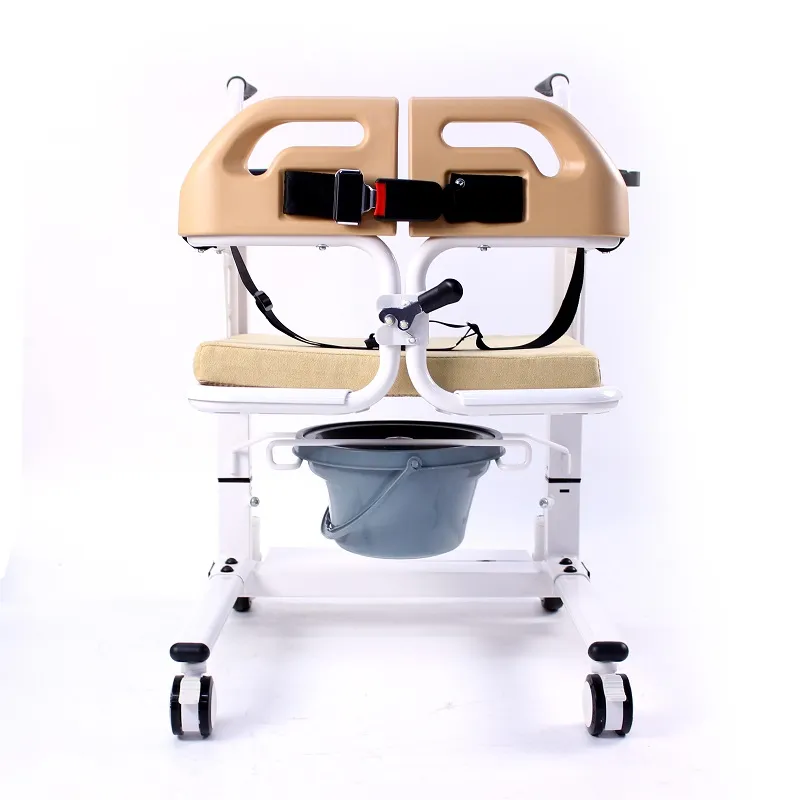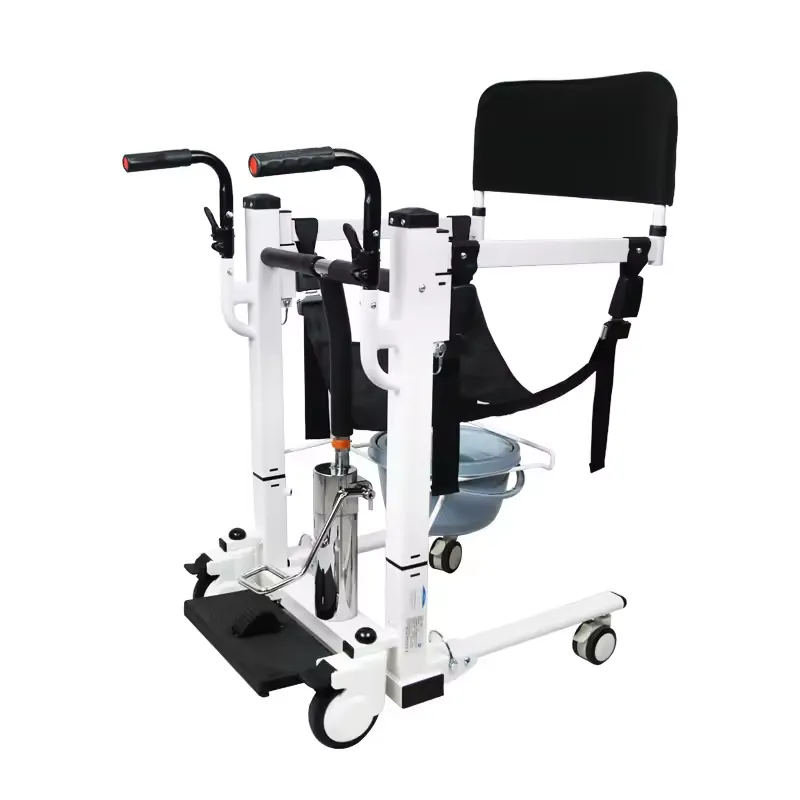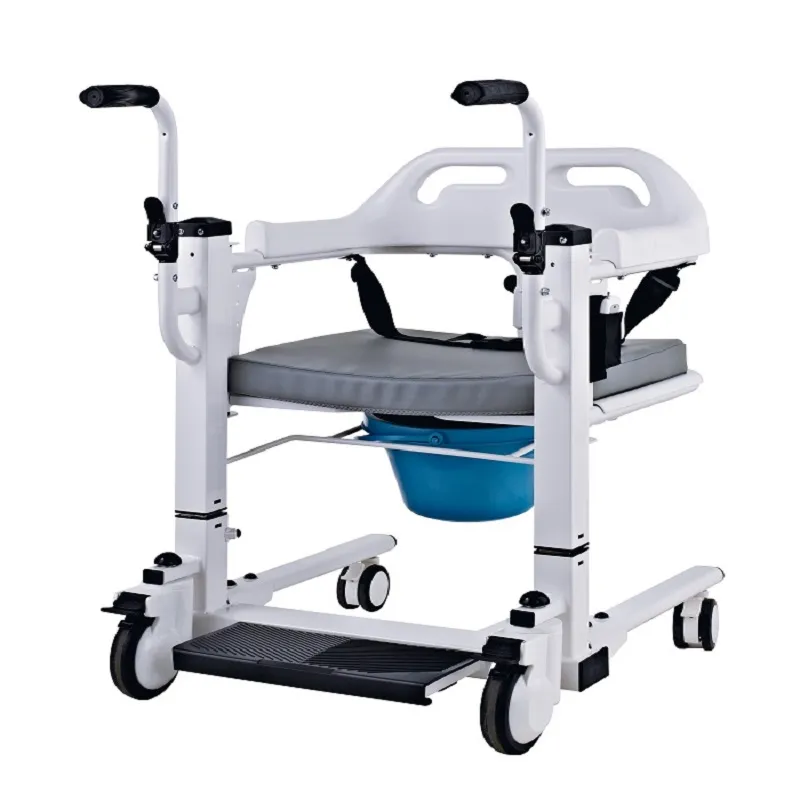In hospitals, nursing homes, rehabilitation centers and home care scenarios, medical transfer chair, as a basic but key nursing auxiliary equipment, plays an irreplaceable role.
Whether it is the movement of patients between floors, the transfer from the operating room to the ward, or the daily assistance of going to the toilet, bathing, and getting in and out of bed, the patient transfer chair plays the core role of a "mobile carrying platform". For most caregivers, purchasers and even ordinary home users, they often have no idea where to start when faced with parameters such as "seat width 450mm", "total height 1050mm", and "maximum load 150kg".
So, what are the sizes of medical transfer chair? How to choose scientifically according to the patient's body shape and usage scenario? What do patient transfer chairs of different sizes represent? This report will conduct a comprehensive analysis from the perspectives of product classification, main parameters, suitable population, transfer scenarios, etc., to help readers clarify their ideas and make professional judgments.

What is a medical transfer chair?
The medical transfer chair, also known as the patient transfer chair, is a professional device designed to assist people with limited mobility to move short distances in medical or nursing facilities. Its core function is to safely and efficiently transfer patients from one location to another without them having to move themselves, such as from the ward to the examination room, from home to the bathroom, etc.
The main features of the patient transfer chair include:
· Equipped with a seat, foot pedal, push handle, moving wheels, and brake system;
· Most of them have functions such as folding, lifting, and split backrests;
· Used in hospitals, nursing homes, rehabilitation centers, and home care scenarios;
· Some models support toileting, bathing, waterproofing, and ramp walking.
Unlike wheelchairs, the core function of the medical transfer chair is "short-term transfer" rather than "long-term riding". The design focuses more on convenience, controllability, and ease of operation for caregivers.

What are the common size parameters of the medical transfer chair?
When we talk about the "size of the medical transfer chair", it actually involves the parameters of multiple key parts, not just the width of the seat. The following are the common size classifications and meanings of the medical transfer chair:
| Dimensions | Universal range | Functional description |
| Seat width | 420mm–550mm | Determines the width of the passenger's hips |
| Seat depth | 380mm–500mm | Determines the length of the thigh support |
| Seat height | 450mm–560mm | Determines whether the feet touch the ground after sitting |
| Backrest height | 350mm–500mm | Determines the strength of back support |
| Handlebar height | 900mm–1100mm | Affects the comfort of the nursing staff |
| Total length/total width | 800mm–1000mm / 550mm–650mm | Related to the door width and elevator width |
| Footrest height | 100mm–200mm | Affects the stability and safety of getting on and off the chair |
| Load bearing capacity | 100kg–200kg | Determines whether it can carry heavy patients |
The above parameters may vary slightly due to differences in brand and product design.

Medical transfer chair size classification - detailed explanation
1. Standard size: the most common patient transfer chair
The patient transfer chair sizes used by most medical institutions are as follows:
· Seat width: 450mm
· Seat depth: 450mm
· Total width: 600mm
· Total length: 950mm
· Load-bearing capacity: 100-150kg
This size is suitable for most adult patients of medium build, with a moderate footprint, suitable for corridors, elevators, and electric doors. The resistance is moderate when the nursing staff pushes it, and the steering is flexible.
Applicable population:
·General adult patients (45–90kg)
·Patients in rehabilitation period
·Daily caregivers of middle-aged and elderly people
2. Widened and reinforced size: suitable for patients with large weight
In order to meet the transfer needs of high-weight or obese people, widened medical transfer chairs are also launched on the market, with typical sizes:
·Seat width: 520mm–550mm
·Total width: more than 700mm
·Load-bearing capacity: 150kg–200kg
This type of patient transfer chair is usually equipped with a thickened and reinforced frame, heavy-duty universal wheels, double-sided brake systems, etc., which can ensure stability while reducing the risk of rollover.
Applicable people:
· Obese patients with high BMI index
· High-weight postoperative rehabilitation patients
· Geriatric wards, ICU emergency and other scenarios
3. Narrow and lightweight size: suitable for home and narrow space
Home or portable patient transfer chair pays more attention to "lightweight and convenient", and common specifications are:
· Seat width: 400mm-420mm
· Seat depth: 380mm
· Total width: about 550mm
· Weight: 8-15kg
This type of transfer chair is easy to shuttle between the bathroom, bedroom, and kitchen at home, and is especially suitable for small-sized families or temporary transfer of bedridden elderly people.
Applicable people:
· Lightweight women, elderly people
· Home care staff operation requirements
· Travel and carry, short-term care use
What are the key factors in choosing the size of the patient transfer chair?
1. Passenger body shape
The height, weight, and leg length of different patients determine the requirements for seat width, seat depth, and load-bearing capacity. Choosing the wrong size of patient transfer chair may result in:
· Thighs hanging in the air → insufficient seat depth;
· Hips under pressure → seat width is too narrow;
· Unstable center of gravity → insufficient load-bearing.
Therefore, when choosing a medical transfer chair, nursing staff should first measure the basic data of the passenger's hip width, thigh length, weight, etc., and select the most matching size segment.
2. Size of the space where it is used
For example:
· The width of hospital corridors and ward doors is generally 800-1000mm;
· The width of family bathroom doors is mostly 600-700mm;
· The net width of the elevator car is 850-1000mm.
Choosing a patient transfer chair with a total width that is too large may make the space inaccessible. Narrow medical transfer chairs with a small turning radius are more suitable for home care or narrow wards.
3. Pushing operation frequency
The height and strength of the nursing staff also affect the comfort of the handlebar height and the center of gravity of the whole vehicle. If the equipment is too high or too heavy, pushing it for a long time will cause a burden on the shoulders and lumbar spine. High-quality products usually indicate the "recommended caregiver height range" in the instructions.

Medical transfer chair Vs. wheelchair: What is the difference?
Although the patient transfer chair is similar to a manual wheelchair or electric wheelchair in appearance, there are essential differences in their design concepts and size standards:
Features | Medical transfer chair | Traditional wheelchair |
| Main purpose | Short-term transfer, nursing assistance | Daily travel, self-care |
| Dimensions | Narrower overall width, narrow space for shuttle | Prioritize stability, slightly larger overall width |
| Seat comfort | General, relatively rigid | High-density foam seat cushion is more comfortable |
| Implementation requirements | Controlled by nursing staff | User-controlled |
| Seat height adjustment | Mostly fixed seat height | Some support adjustable footrest or electric lift |
Therefore, the medical transfer chair cannot be directly used to replace a wheelchair or vice versa. The two have clear positioning and should be selected according to specific needs.
Is it worth customizing the size of the medical transfer chair?
For some patients with special care needs, such as:
· Paraplegics need to support their backs with high degree of support;
· Amputees need to offset the center of gravity design;
· Patients are over 1.9 meters tall and weigh more than 150kg;
Standard transfer chairs are difficult to fully adapt. At this time, you can consider customizing the size of the medical transfer chair, which can be adjusted according to:
· Specific seat width and load-bearing capacity;
· Push handle position height;
· Back angle and armrest height;
Well-known domestic and foreign brands such as Haiskel, Xinbesi, Invacare, Drive Medical, etc., all provide OEM customization services.
However, it should be noted that customized products are more expensive and have a longer production cycle. They are generally suitable for users with severe illnesses and long nursing cycles.
Correctly understand the size and choose the transfer chair scientifically
The size of the medical transfer chair is far more than just "seat width". It is a systematic set of design indicators that directly affects riding safety, nursing efficiency and space adaptability.
1. For standard adults, a medical transfer chair with a seat width of 450mm is the most common;
2. For people with high weight or obesity, a widened and reinforced type should be selected;
3. For home scenes and light needs, a narrow medical transfer chair is more suitable;
4. For complex spaces or special patient body shapes, it is recommended to consider customized specifications.
A patient transfer chair with the right size not only carries the body, but also carries a deep respect for the dignity of life and the humanities of nursing.
Do you offer mobility aids like transfer chairs and rollators?
Yes—Dayang Medical specializes in comprehensive mobility solutions, including electric transfer chairs, rollators, shower chairs, commodes, and walking sticks. Manufactured in our two Foshan-based production hubs, all devices are ISO9001/ISO13485/FDA/TUV-certified and CE approved. We offer customizable orders, bulk-purchase pricing, wholesale discounts, and low-cost quotes ideal for distributors, care homes, and hospitals. As a trusted Chinese factory with promotional options and cheap prices, we deliver reliable care solutions globally.










